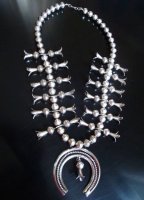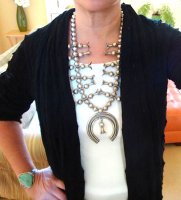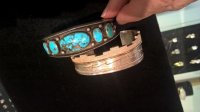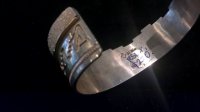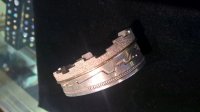Of course! I’ll attach the photos below (including a necklace I forgot, which is turquoise nuggets between narrow silver tube beads). I tried to make them better quality so you can see the details, my photography skills are... not the best, ha.
The cuff definitely stands out to me as separate in terms of style. It’s such a beautiful etching — I can definitely see the Northwestern connection in terms of the scenery, etc.
The square one was my grandmothers favorite, she wore it nonstop. To be totally honest, I don’t know if that’s the original chain (from Mexico). It’s reversible, turquoise on one side and... some brown stones (that’s embarrassing, I just don’t know what they are) on the other.
The first and last photos were from the same piece (the long square turquoise piece), which is beautiful.
And I know nothing about the pendant of the man! I wish I did. Kokopelli seems like a good guess, though the pose isn’t the traditional one?
Anyway, I’m so glad you liked them and I appreciate your response!
View attachment 4549955 View attachment 4549956 View attachment 4549957 View attachment 4549958 View attachment 4549959 View attachment 4549960 View attachment 4549961 View attachment 4549962 View attachment 4549963 View attachment 4549964 View attachment 4549965 View attachment 4549966
Welcome and thanks for sharing your grandmother’s jewelry. It is beautiful and looks great on you! Definitely a special way to remember her. I’ll tell you as much as I can about each piece.
The first necklace is a mix of bead types that I don’t know if I have seen together like this before. The small tan beads are made of shell and called heishe, and they are strung with silver “Navajo pearls” and turquoise nuggets. Heishe is very desirable when it is all done by hand as it’s a time-consuming process, but I haven’t developed the skill yet to distinguish handmade from manufactured heishe. The center rectangular turquoise stone with silver caps is very unusual. The somewhat eclectic style of this necklace makes me think 70’s, and if I had to guess I would say this was assembled from purchased parts, possibly by a Navajo artist. The sun mark on the silver cone beads is not an artist’s hallmark but a decoration that is commonly found on manufactured beads of that shape.
The bracelet is scrimshaw, or at least made to look like scrimshaw—etchings on bone or ivory. This is something I know almost nothing about, but I think that it is commonly done on composite (plastic) material in place of real bone or ivory. You might be able to tap it on your teeth to get an idea if it’s plastic or not. I haven’t known Native Americans to work in this style but I suppose it’s possible for Pacific Northwest indigenous artists.
The third necklace with the dancing human figure and inlay stones is Native American. I would not call the figure a Kokopelli (who is almost always depicted as a humpback playing a flute) although I can see the similarity. The bird symbol on the back is a pictograph artist’s hallmark. I feel like I have seen this one before but wasn’t able to find it in my hallmark book. The stones are jet, turquoise, and coral. It is on a handmade chain as well which is nice.
The rectangular pendant was likely added to the filigree style Mexican chain by your grandmother; it was probably purchased as just a pendant. I think that the pendant is Native American but I’m also wondering if it could possibly be Mexican? It looks to me to be handmade and hand stamped. I’m pretty sure the top and bottom stones on the back are coral but I’m not sure what that middle stone is.
Those long silver tubes on the last necklace are manufactured. This, like the first one, may be assembled by a Native American artist out of purchased parts. Or, it could be “Southwest Style,” meaning not Native American made.
As far as cleaning, you would not damage them if you were to polish them to your liking with a cloth. Don’t dip or use creams. The look you prefer is really up to individual preference. A lot of people do like vintage pieces to have a patina though, so if you’re planning on selling it’s always best to avoid polishing and let the buyer decide.
Hope this helps!




